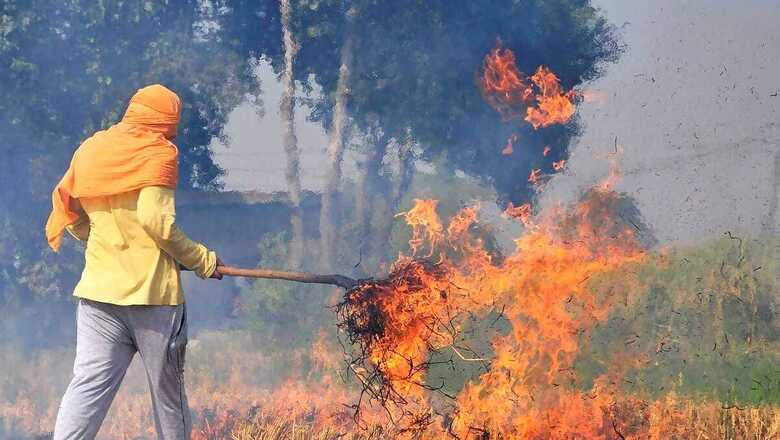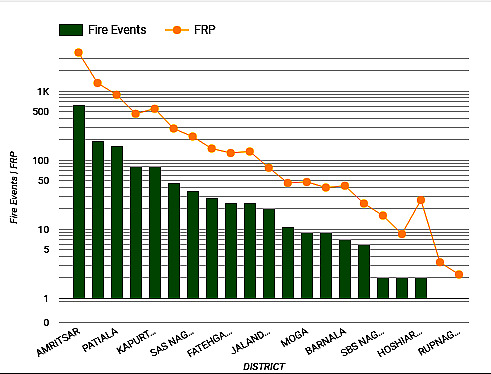
views
The Aam Aadmi Party (AAP)-led Punjab government’s ambitious plan to halve the stubble burning incidents in the state seems to have gone up in smoke. The fire counts have increased drastically compared to last year, not just in Punjab, but Haryana and other neighbouring states.
Even as state governments frantically promote distribution of Crop Residue Machines (CRM) and the subsidies, a large number of farmers are setting fire to their freshly-harvested fields — a practice banned by the National Green Tribunal (NGT) in 2015.
With one of the largest areas under paddy, Punjab continues to be the biggest contributor of farm fires. But out of its 23 districts, it is the border district of Amritsar, which accounts for over 46% of the total farm fires reported this season. Of the total 1,389 incidents, over 644 have been detected in Amritsar alone, followed by Tarn Taran (192) — both in Majha. Unlike last two years when Sangrur topped the list with highest fire counts by the end of the harvesting season, this year the district has only recorded 81 fire counts so far.

Why So Many Farm Fires in Amritsar?
According to experts, this may have been due to the high acreage under short-duration paddy varieties as well as Basmati in the region. The unprecedented floods in July – coinciding with the sowing time for Kharif crops — left little time for farmers, who opted for paddy varieties which mature faster than others.
“A major reason is that farmers here tend to go for a three-crop cycle, mostly vegetables. So, the early they harvest paddy, the fast they will be able to sow the next crop – peas or potato – and then go for Rabi crops like wheat in December. Harvesting also began early this year as there was a long dry period with no rains which may have led to a spike in residue burning,” says KK Gill, Principal Agrometeorologist from Punjab Agricultural University (PAU).
Farmers have a small window to clear their fields as peas are generally sown in early to mid-October. Amritsar is also known for Basmati cultivation with about 1.35 lakh hectares of the district under it this year. Though it matures early, Basmati does not generally contribute much to stubble burning, as its residual stalks are generally soft and are more likely to be used as cattle fodder.
Even though this fine variety of rice has huge demand abroad, most small farmers do not prefer it due to absence of a fixed MSP. Out of the total area under paddy, Basmati generally covers 18% of it. While the Malwa region consisting of southern districts like Bathinda, Mansa, Sangrur also serves as the Cotton belt – an alternative to paddy.
No Compensation, No Solution
The Punjab government has now laid thrust on short-duration paddy varieties with an intent to mitigate the worsening groundwater crisis in the state. These varieties – PR126, PR127 are less water-intensive and mature early compared to the Pusa-44, which has been banned by the government from next year. However, there is a significant difference in the yield too.
Agricultural experts say this will not eradicate the problem of stubble burning unless governments also compensate farmers. “Farmers have long been demanding Rs 2,500 per acre for not burning stubble, but nothing has happened in this regard. If the solutions proposed put additional financial burden on farmers, then they will certainly not work,” says Devinder Sharma, Punjab-based food policy analyst.
Punjab had over 1.17 lakh Crop Residue Management (CRM) machines and planned to acquire 25,000 more this year. The plan was to manage 11.5 million tonnes (MT) of paddy straw through in-situ management and about 4.67 MT through ex-situ management. However, farmers rue lack of financial support in using these machines – and say the problem will not be solved unless there is a policy change.
“It comes down to the same question every year. If the government is ready to provide the right seeds to farmers and helps us get rid of the residues with no additional cost, then why will there be stubble burning? Most small, marginal farmers can’t even avail the subsidies on these machines, which also require a high power tractor to run. Why not provide the compensation?” says Avtar Singh Korjiwala of the Krantikari Kisan Union.
The ex-situ management of stubble is another option where the paddy straw is collected and dispatched for use in briquette/pelleting plants, bio-ethanol plants, biomass-based power plants as well as cardboard factories. From nearly 53,000 in 2019 to over 71,304 in 2021, the number of crop fires raging across the state has only risen every passing year, except a significant drop last year.




















Comments
0 comment